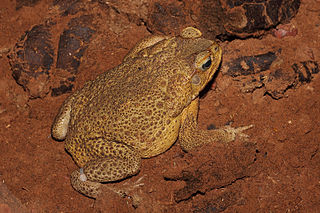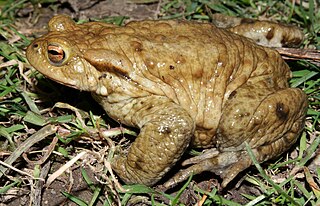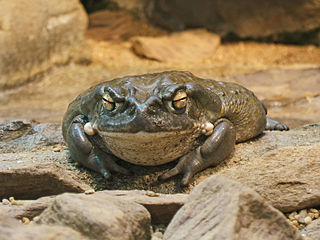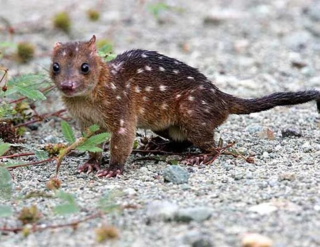
The cane toad, also known as the giant neotropical toad or marine toad, is a large, terrestrial true toad native to South and mainland Central America, but which has been introduced to various islands throughout Oceania and the Caribbean, as well as Northern Australia. It is a member of the genus Rhinella, which includes many true toad species found throughout Central and South America, but it was formerly assigned to the genus Bufo.

Bufo is a genus of true toads in the amphibian family Bufonidae. As traditionally defined, it was a wastebasket genus containing a large number of toads from much of the world but following taxonomic reviews most of these have been moved to other genera, leaving only seventeen extant species from Europe, northern Africa and Asia in this genus, including the well-known common toad. Some of the genera that contain species formerly placed in Bufo are Anaxyrus, Bufotes, Duttaphrynus, Epidalea and Rhinella.
Bufotoxins are a family of toxic steroid lactones or substituted tryptamines of which some are toxic. They occur in the parotoid glands, skin, and poison of many toads and other amphibians, and in some plants and mushrooms. The exact composition varies greatly with the specific source of the toxin.
Bufagin is a toxic steroid C24H34O5 obtained from toad's milk, the poisonous secretion of a skin gland on the back of the neck of a large toad (Rhinella marina, synonym Bufo marinus, the cane toad). The toad produces this secretion when it is injured, scared or provoked. Bufagin resembles chemical substances from digitalis in physiological activity and chemical structure.

Bufotalin is a cardiotoxic bufanolide steroid, cardiac glycoside analogue, secreted by a number of toad species. Bufotalin can be extracted from the skin parotoid glands of several types of toad.

The Colorado River toad, also known as the Sonoran Desert toad, is a toad species found in northwestern Mexico and the southwestern United States. It is well known for its ability to exude toxins from glands within its skin that have psychoactive properties.

A true toad is any member of the family Bufonidae, in the order Anura. This is the only family of anurans in which all members are known as toads, although some may be called frogs. The bufonids now comprise more than 35 genera, Bufo being the best known.

The New Guinean quoll, also known as the New Guinea quoll or New Guinea native cat, is a carnivorous marsupial mammal native to New Guinea. It is the second-largest surviving marsupial carnivore of New Guinea. It is known as suatg in the Kalam language of Papua New Guinea.
Rhinella amabilis is a species of toads in the family Bufonidae that is endemic to Ecuador, only occurring in a severely fragmented area less than 100 square kilometres (39 sq mi).
Rhinella arborescandens is a species of toad in the family Bufonidae. It is endemic to Peru and only known from its type locality near Mendoza, northern Cordillera Central, in the Amazonas Region. It is unusual among Rhinella toads because it is arboreal, hence the specific name arborescandens, derived from Latin arbor for tree and scando meaning to climb.

Rhinella arenarum is a species of toad in the family Bufonidae that is found in southern Brazil, Uruguay, Paraguay, Argentina and Bolivia. Rhinella arenarum inhabits small ponds or bogs with stagnant water, in dry, temperate habitats, mostly in open areas. It is locally common. While it is collected for educational and scientific uses and also suffers from road kills, it in general is not threatened. Fossils representing this species are known with certainty from the late Pliocene to the Holocene of central Argentina.
Rhinella humboldti is a species of toad in the family Bufonidae. It is found in Colombia, Venezuela, Trinidad, and the Guianas. This species was originally considered to be a subspecies of Rhinella granulosa.

Rhinella crucifer is a species of toad in the family Bufonidae. It endemic to Brazil and known from the Atlantic Forest of eastern Brazil between the states of Ceará in the north and Rio de Janeiro in the south. Common name striped toad has been coined for it. "Rhinella pombali" is a hybrid between Rhinella ornata and this species.

Rhinella dorbignyi is a South American species of toad in the family Bufonidae. The specific name, dorbignyi, is in honor of French naturalist Alcide d'Orbigny. Its common name is d'Orbigny's toad or Dorbigny's toad [sic].

Rhinella jimi is a species of toads in the family Bufonidae. It is endemic to northeastern Brazil and known between Bujaru in northeastern Pará and Maranhão in the north, south to Bahia and Vitória, Espírito Santo. Prior to its description in 2002, it was confused with Rhinella schneideri. The specific name jimi honors Jorge Jim, a Brazilian herpetologist. Common name Jimi's toad has been coined for it.

Rhinella proboscidea is a species of small South American toad in the family Bufonidae, common in the Amazon rainforest. It is the only species known to practice reproductive necrophilia.

Rhinella, commonly known as South American toads, beaked toads or Rio Viejo toads, is a genus of true toads native to Neotropical parts of Mexico, Central and South America. Additionally, the cane toad has been Introduced to Australia, the Caribbean, the Philippines and elsewhere.
Rhabdias alabialis is a species of parasitic nematode in the family Rhabdiasidae. It was first found in lungs of the cane toad Bufo marinus in Costa Rica and Nicaragua. It can be distinguished from its cogenerates by its head morphology, i.e. its lips or pseudolabia absence, a slitlike oral opening, and its buccal capsule being triangular shaped in the apical view.

Rhinella loba is an extinct true toad that inhabited the South American Pampas during the late Pliocene. It is closely related to the present day Argentine toad Rhinella arenarum and represents to date the only diagnosable extinct true toad species from South America.













